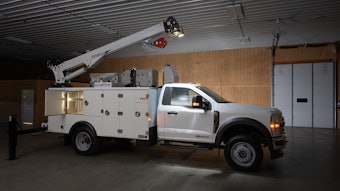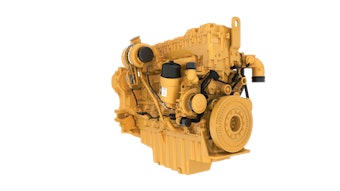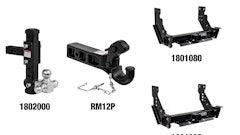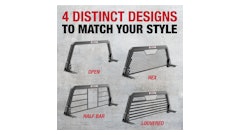
The latest generation of heavy-duty diesel pickup trucks has moved the towing goal posts. Over the last decade, the published maximum towing capabilities of the 350/3500 and larger diesel pickups has increased anywhere from 38% to 83%, depending on the truck model. It’s now possible to move equipment with a heavy-duty pickup truck that you would previously need a medium-duty truck to tow.
How much capacity are we talking about? The largest pickup available, the 2015 Ford F-450, gained 7,000 lbs. in gross combined weight (GCW) rating to reach 40,000 lbs. - half the capacity of a typical Class 8 truck. It offers a maximum fifth-wheel/gooseneck towing capacity of 31,200 lbs., measured using the Society of Automotive Engineers J2807 standard. Maximum conventional towing capacity is 19,000 lbs.
The 2015 F-350 increases maximum fifth-wheel/gooseneck towing capacity, as well, to 26,700 lbs. from 23,200 lbs., and the GCW rating rose 4,500 lbs. to 35,000 lbs. The conventional hitch rating is 19,000 lbs. In 2005, the 6.0-liter diesel F-350 with dual rear wheels had a maximum fifth-wheel towing capacity of 16,600 lbs. That is a whopping increase of 10,100 lbs., or 60.8%, in towing capability.
Of course the vehicle’s GVW is going to fluctuate with the various options and cab styles, which will impact available payload and towing capacity. And payload has a significant impact on the actual towing capability since you can't exceed the GCW under any circumstances. The axle ratio and whether the pickup is a single-rear wheel or dual-rear wheel configuration also change towing capability.
One of the enabling factors for increased towing capability is the tremendous torque transmitted to the ground through the current generation of diesel engines. For instance, the 2015 Ford Super-Duty pickups are powered by a second-generation 6.7-liter Power Stroke V8 turbodiesel engine that pumps out 440 hp and 860 lbs.-ft. of torque. This compares to 400 hp and 800 lbs.-ft. of torque for the first-generation Power Stroke. A key upgrade that made this possible is a larger turbocharger for increased airflow and more power.
“The improvements we’ve made essentially give Super Duty customers an engine that is also designed for our larger F-650 and F-750 medium-duty trucks,” says Robert Fascetti, Ford vice president, Powertrain Engineering.
The chassis was also modified to haul more. A high-capacity towing package that includes new front springs and a wide-track axle boost the 6.7-liter Power Stroke F-350's standard 31,900-lb. GCW rating to 35,000 lbs.
The Chevrolet Silverado and GMC Sierra HD pickups have also pushed towing limits for 2015, but the company emphasizes that real-world towing confidence is about more than the spec sheets. Maximum available payload is 7,374 lbs., up from 7,222 lbs. Maximum available conventional towing is 19,600 lbs. with the available factory hitch, up from 18,000 lbs. Maximum available fifth-wheel towing is 23,200 lbs., up from 22,500 lbs.
In 2005, the maximum fifth-wheel/gooseneck towing capacity for the Chevrolet Silverado 3500 was 16,700 lbs. That is a difference of 5,800 lbs., or 38.9%, from the current capacity. The 2005 Silverado pickups were then powered by a Duramax 6600 diesel that produced 310 hp and 605 lbs.-ft. of torque. The current Duramax 6.6-liter turbo diesel is rated at 397 hp and 765 lbs.-ft. of torque.
Changing the Rules
Manufacturers can make many claims regarding towing capability, but there are standards available to ensure that the trucks will perform to expectations while pulling these loads.
For instance, Ram Trucks has adopted SAE J2807 standardized tow-rating practices across all three full-size pickup truck segments, including the 1/2-ton Ram 1500, 3/4-ton Ram 2500 Heavy Duty and 1-ton Ram 3500 Heavy Duty. “Ram Truck has been preparing for integration of the SAE towing standard over the past few years, and adding heavier 3/4- and 1-ton trucks to the criteria gives it more teeth,” says Mike Cairns, director of Ram Truck Engineering at the Chrysler Group. "For too long, an uneven playing field existed and towing capacities went unchecked.”
The SAE J2807 towing standard outlines dynamic and performance criteria as it relates to a given vehicle. Examples within the standard include a number of tests while towing: 0-60 MPH time allowance, tackling the notorious Davis Dam Grade while maintaining no less than 40 MPH for single-rear-wheel trucks and 35 MPH for dual-rear-wheel trucks, a constant radius understeer test while increasing speed and a sway maneuver using aggressive steering input. The purpose is to put all trucks through the schedule of tests in which operators will likely see in the real world.
While testing to the SAE J2807 standards, Ram Trucks was able to dramatically increase its published tow ratings for 2015 with both gasoline and diesel engines. The Ram 2500 with a 6.7-liter Cummins diesel now offers a maximum towing capacity of 17,970 lbs. The Ram 3500 with a 6.7-liter Cummins diesel has an impressive 30,000-lb. maximum tow rating.
In 2005, the Dodge Ram 3500 offered a maximum towing capacity of around 16,350 lbs. That is about 13,650 lbs., or 83.5% less than the maximum towing capacity of the current Ram 3500! Also consider that the 2005 Dodge Ram Heavy Duty used a Cummins 600 V6 turbo diesel engine producing 600 lbs.-ft. of torque at 1,600 rpm and 325 hp at 2,900 rpm. The 2015 Ram 3500 offers a substantial power increase with an available 6.7-liter Cummins High-Output Turbo Diesel that produces 385 hp at 2,800 rpm and 865 lbs.-ft. of torque.
Gain Efficiency and Save Fuel
Assume you have a gooseneck equipment trailer rated at a 30,000-lb. GVW. If that trailer weighs 9,900 lbs. empty, you can haul a net payload of 20,100 lbs. A Caterpillar 308E2 CR mini-excavator weighs in at 18,519 lbs., a John Deere 310K 4WD backhoe-loader with extendable hoe weighs in at 14,352 lbs., a John Deere 344K wheel loader weighs in at 18,408 lbs. and a Volvo SD 75 soil compactor weighs in at 16,561 lbs.
While some of the machines are at the upper limits of what you would realistically want to tow with a pickup, you can see the possibilities. The increased capacities of today’s heavy-duty pickups have grown to the point where it is now possible to move many machines from jobsite to jobsite without having to tie up your lowboy truck. What today’s heavy-duty trucks are rated to haul is truly remarkable compared to even 10years ago.
The impressive gains in towing capability mean you may be able to downsize your trucks or replace larger tow vehicles in the fleet for many applications. In some cases, this can yield substantial fuel savings.
“We have had a lot of discussion around the question of HD buyers moving down to a light-duty pickup, or light-duty drivers moving down to a midsize truck, such as the Colorado or Canyon,” says Wilkinson. “Ultimately, the customer needs to decide, so from our perspective, more choice is better. The Colorado can tow up to 7,000 lbs. when properly equipped, but I think that the consensus is that if you are towing that much trailer on a regular basis, you may find a light-duty, or even a HD pickup a better choice. It’s the same with a light-duty pickup – a Silverado and Sierra can tow up to 12,000 lbs. when properly equipped. But again, if you tow that much on a regular basis, a HD pickup with a diesel engine and diesel exhaust brake is probably going to feel more confident in the mountains.”
The decision really comes down to what you are trying to accomplish. “If you tow a trailer occasionally, a smaller truck can get the job done, and will be more economical and more enjoyable the 98% of the time it doesn’t have a trailer behind it. But for customers who tow a heavy trailer regularly, it is hard to beat a 3/4- or 1-ton HD pickup with a diesel. Many commercial customers find a gas-powered HD a good compromise. The initial cost is much lower than a diesel, yet the truck has real HD capability when you need to tow a heavier trailer.”
Fuel economy can also play into the equation. “There are no simple answers to the fuel economy question,” says Wilkinson. “Engine displacement is just one of many variables that determine real-world economy, so there are really no rules of thumb.”
Consider the pros and cons of smaller displacement engines. “At lighter vehicle loads, a smaller displacement diesel engine will produce better fuel economy than a larger displacement engine at the same load,” says Wright. “An incremental reduction in engine displacement in a loaded truck will typically cause the fuel economy to be similar or, in extreme cases, degrade below those of the larger engine." This can be due to several factors:
- In boosted diesel engines, a smaller displacement engine would require increased engine speed to deliver the larger power levels of a larger displacement engine.
- Final drive ratio increases are required to deliver comparable grade launch capability as the larger displacement engine. This will cause engine operating speeds of the smaller displacement engine to be higher than the larger displacement engine at the same vehicle speed.
- Increased boost pressures results in higher fuel flow demand.
- There is decreased transmission efficiency associated with the higher engine speed requirements.
- An increase in torque converter clutch unlock conditions is required for acceleration, causing a loss in efficiency and higher engine speeds.
- In general smaller engines, must work harder and produce more NOx emissions, leading to more expensive aftertreatment up to and including more urea usage on selective catalytic reduction (SCR) applications.
- Smaller displacement diesel engines may require the benefits of additional transmission gear ratio spread and lower gear ratios (e.g., eight-speed transmissions) to provide the capability to get loads moving while maintaining vehicle drivability and fuel economy.
How often will you tow a trailer? “If you are towing a heavy trailer on a regular basis, there is no question that a diesel HD will give the best fuel economy,” says Wilkinson. “If you are only towing occasionally, a smaller pickup will be much more economical overall, even if it has worse fuel economy with a trailer behind it.”
But engine displacement is only part of the overall efficiency equation. “Would you be more efficient with a smaller displacement diesel engine in a heavy-duty pickup or chassis cab vs. a (larger) medium-duty truck? The answer is generally yes,” notes Slevin. “I am an engineer, so I am always going to think of that added situation where something may not be true.”
The reasoning is more complicated than simply engine displacement. Consider that the GVWs in the Ford Super Duty line go up to 19,500 lbs. on the F-550. “Our medium-duty starts at 26,000 lbs. and goes to around 37,000 lbs.,” says Slevin. “As you can imagine, the frame has to be much stronger. It is massive; it just weighs more. The axles, wheels, tires and everything that goes into that medium-duty truck, except the cab, needs to be heavier duty. You get a weight penalty with that.”
But even more important than the weight are the increased parasitic losses in the axles, transmissions, etc. “Turning over great big ring gears in that rear axle takes a lot more energy,” says Slevin. “The heavy-duty pickup or chassis cab, when you look at the vehicle as a whole, would be much more efficient, particularly if you do any amount of driving unloaded. The unloaded fuel economy difference would be huge.”
Slevin uses an example of a smaller car carrier that has a four- or five-car capacity. “I would want to use a heavy-duty pickup or chassis cab vs. a medium-duty truck because it is going to be more efficient, especially since a significant amount of the time would be unloaded," he points out.
Determined to Downsize?
Ram has seen some of its customers take advantage of the newfound capabilities. “We have seen Class 6 owners move down to our Class 5 trucks,” says Romain. “The investment is significantly less. And depending upon their vocation, the capability is more than adequate. We have also seen in the past seven to eight years the new vocation of 'hot shot driver.' You have guys who were formerly Class 7 or Class 8 independent freight haulers and they bought themselves a dually. Now they are hauling freight with a 3500 pickup.”
You really need to understand your duty cycle before making a decision to downsize. “The engine should be sized right for the job,” Romain emphasizes. “There is a crossover point where it goes to less efficiency. It comes back to the right size engine with the right transmission ratios and the right axle for the job.”
“You still need to purchase your vehicle for the worst case load condition or capability,” adds Troy Davis, head of Ram Chassis Cab engineering. “The capability has to match your criteria.”
Durability is also a consideration, so you need to consider your duty cycle. If you are going to haul 30,000-lb.-plus loads on a continual basis, you probably want to step up to a medium-duty product. “Pick the right tool,” advises Slevin.





























